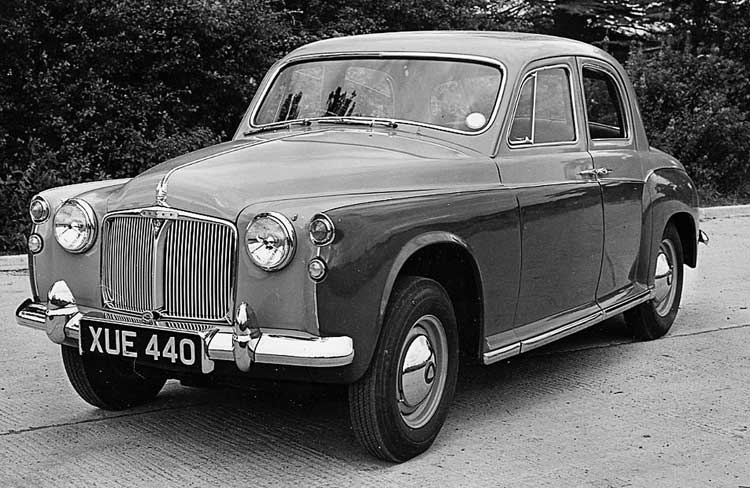Rover P4
Brian Sewell remembers the time when the name of Rover stood for brilliance and innovation - rather than failure

Rovers made since the end of World War II are known by P numbers. The P stands for Post-War - so it is said - but as the first cars to be distinct from the pre-war series were numbered P3, no one now is certain to which cars P1 and P2 apply.
Rovers made since the end of World War II are known by P numbers. The P stands for Post-War - so it is said - but as the first cars to be distinct from the pre-war series were numbered P3, no one now is certain to which cars P1 and P2 apply.
P1 could be the pre-war 10hp to 16hp saloons and 12hp Tourer introduced in 1936 and revived for 1946-48; and P2, it is reasoned, must be the same cars with new engines, all record of which is lost - but this seems improbable, for in 1948 two new engines, the 60 and 75, were ready for the P3, a car that was virtually indistinguishable in style from its Thirties. antecedents.
It must remain a mystery - unless someone, somewhere in the depths of Solihull, has a Rover 16 saloon fitted with a 75 engine, and a Rover 12 Tourer powered by a 60. The P3, I observe in passing, with a total production of 9,111 over two years, must be the rarest of all post-war Rovers.
The one car that is not a mystery is the P4, the "Auntie'' Rover, of which more than 130,000 were made in an infinity of guises, variations, modifications, transitions and riddle-me-ree. I loathe that nickname, for it does no justice to a car that in its first incarnation was almost as startling as the Studebakers launched by Raymond Loewy in 1946 - indeed, Rover had one of these and tried its body on a Rover chassis. This first P4 was well enough engineered for Tickford and Farina to build drophead coupé prototypes, and for Rover to be sublimely confident in the madcap idea of shoe-horning into another roofless version a giant gas-turbine engine that made it reach beyond 150mph on the Jabbeke motorway.
In its saloon form, this Rover was known to boys of my generation not as the P4 but as the 75, and in 1949 it seemed the most brilliant, the most forward-looking car of its day, the first full-width, streamlined Rover, all corners rounded, all contours smooth, sans running boards, sans separate headlamps, the great Cyclops' eye of a third headlamp set in the prow that had no conventional radiator grille.
It was to memories of this car and its worthy historical identity, not to "Auntie'', that Rover tried to peg the 1999 model 75, with which Rover has just slipped into the Waters of Oblivion.
Rover made this original icon for three years before it gave way to pressure from its customers and began the tinkerings and alternatives with which Rover nerds persistently bore enthusiasts. The purest, the iconic 75, has the Cyclops' eye and not the relic of a Rover radiator; at the rear, below too small a window for good visibility, its boot slopes steeply and elegantly, but offers too little room for luggage; it is a body in which the designers gave primacy to line.
From its looks, one might suppose the 75 to be of monocoque construction, but it has a conventional chassis underneath its partly aluminium body. Its straight-six engine is of even longer stroke and narrower bore, thoroughly old-fashioned and contrary to the European trend for squarer engines. At 2,103cc and 75bhp pulling a laden weight of a ton-and-a-half, its acceleration was never dazzling, its maximum speed of 82mph no better than that of the pre-war 16 with its straight six of 2,147cc.
Even so, no one called it "Auntie''. That mockery came when Rover's designers played Odysseus and snuffed out the Cyclops' eye, replaced the slatted grille with the foul upright spread of a conventional radiator, squared the wings, humped the boot and devised a wrap-round rear window in three parts, that let in a little light for sufferers from claustrophobia.
They enlarged the engine to 2,286, 2,625 and 2,639cc and reduced it to four cylinders of 1,997 and 2,286cc, offering power outputs of 60, 80, 90, 100, 102, 105, 110, 115 and 123bhp. They tinkered with the brakes, the suspension and the gears; the steering-column gear lever of the original 75 was replaced by a long, dog-legged and whippy lever pivoted on an exposed ball-joint on the transmission tunnel; the delectable free-wheel that had made changing gears in the reluctant box so much easier and clutchless, was replaced by overdrive, and, conceding to the demand for automatic gears, they devised the ghastly semi-automatic Roverdrive system.
The P4 gathered weight, bulk and resistance; in its most powerful incarnation, its 115bhp engine with twin carburettors could propel it to 100mph, but its petrol consumption averaged 18mpg. By the time the Rover 3-litre appeared in 1959, the P4 looked staid, dull and antique.
It plodded on until 1964 and then, after 15 years in production, was withdrawn. Its engine, bored out to 2,995, lived on in the 3-litre until 1967, but that was the first P5 and is quite another story. The late models deserved to be dubbed "Auntie'', but the very first did not - and it is only the very first that has classic status; even so, it was wildly upstaged by the Citroën DS.
Subscribe to Independent Premium to bookmark this article
Want to bookmark your favourite articles and stories to read or reference later? Start your Independent Premium subscription today.

Join our commenting forum
Join thought-provoking conversations, follow other Independent readers and see their replies